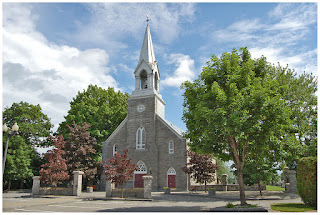The community of Neuville is located in the Quebec Greater Area (Portneuf county), on the Chemin du Roy, the first Canadian road linking Quebec City to Montreal since 1734. The town stands on the northern bank of the St. Lawrence River, some thirty km from Quebec City downtown.
Neuville (population 3800) is one of the oldest parishes in Canada. Indeed, the first settlers come here in 1665. Today, Neuveille is perched atop three ranges of marine terraces that have dominated the St. Lawrence River ever since the glaciers melted.
There are about two dozens remarkable historical buildings in varying styles there and guided tours are available to many of the old homes especially on rue des Érables. This street was opened on the original Chemin du Roy, but is now bypassed by Highway 138.
Historically, the community of Neuville was renowned for supplying limestone to many Quebec buildings and sites, as well as for its shipyard. Later, since the 20th century, the village underwent a period of hotel and resort development.
 |
| Church of Saint - Francois-de-Sales |
The Church of Saint-François-de-Sales, built in 1854, presents twenty-six paintings by artiste Antoine Plamondon (1804-1895), who also served as mayor of the village.
The Seigneurial Manor of Larue, built in 1835 on a small rolling hill, is one of the major buildings that make up Neuville’s architectural heritage. The Rue du Quai leads to the quay and the marina, which welcomes boating enthusiasts each summer.
 | ||||||
| Castel Vauquelin Hotel - Neuville, QC |
Neuville, QC is 210 km (2 hrs.) from St. Hyacinthe and 34 km (35 min.) from Quebec City.



